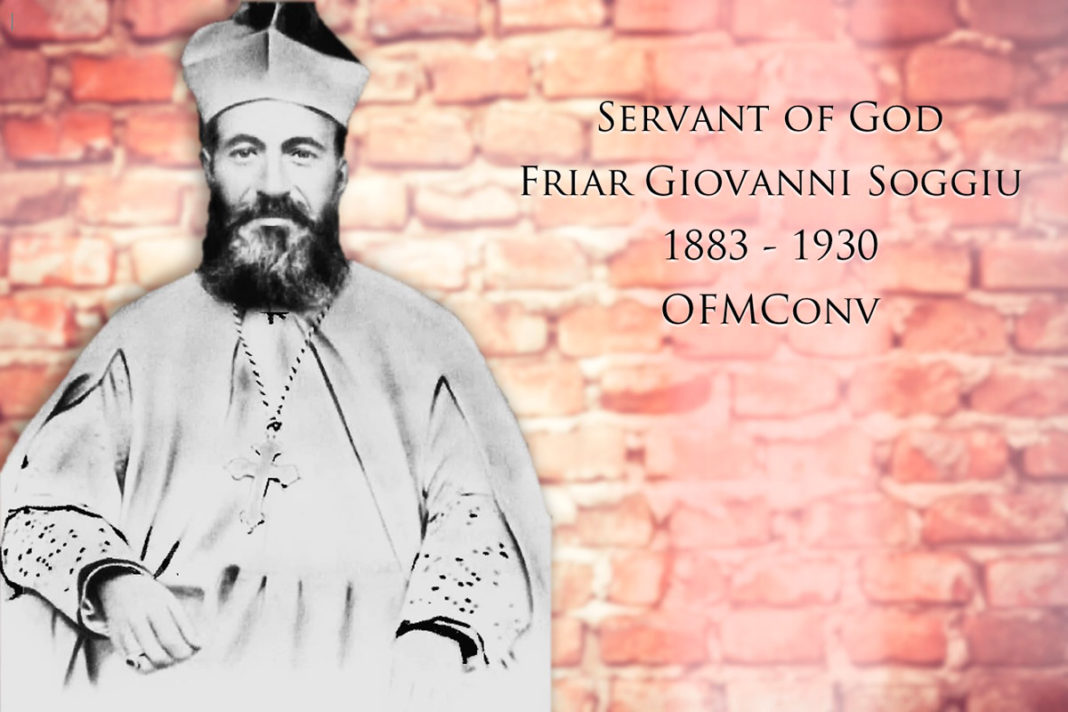Giovanni SOGGIU was born on April 1, 1883, in Norbello, Italy. He was the son of Antonio SOGGIU, an elementary school teacher, and Caterina CONTINI, a housewife, originally from Ghilarza, Italy. Giovanni was baptized two days after his birth. He attended elementary school in Norbello. In 1895, the whole family moved to Ghilarza, probably because his mother inherited a house there.
In 1894, eleven year old Giovanni moved to Sassari, Italy, where he would attend middle school, high school and university, graduating with a law degree. The family rented a small apartment for him in Sassari and one by one, Giovanni’s younger brothers would follow him to Sassari. As the eldest, he was the head of the household and guided his brothers in their studies and in Christian life.
In 1905, Giovanni earned a degree in law when he was just twenty-two years of age. His thesis was entitled, “The Church and Slavery.” Despite the anti-clerical environment at the university, his work courageously underlined and defended the decisive contribution of the Church in the abolition of slavery.
In 1908, after fulfilling his military service and spending a year with his family, he asked to be admitted to the Order of Friars Minor Conventual at the Friary of San Francesco d’Assisi in Oristano, Italy. He embarked on his journey of initial formation with joy and commitment. At the same time, while studying Franciscan spiritual documents, he also studied theology and canon law.
On July 28, 1912, he was ordained a priest in Iglesias, Sardinia. However, he continued his studies and received a doctorate in theology on December 23, 1913.
In 1914, he served as Pastor of the cathedral in Bosa, Italy. In 1917, he left the parish for a short time to serve as a military chaplain. He returned in early 1919 and resumed his role as Pastor. In the summer of that year, during the Provincial Chapter celebrated on July 15-24, he was appointed Provincial Secretary and Novice Master. At the following Provincial Chapter of 1922, he was reconfirmed as Novice Master and was elected Guardian of the friary in Oristano.
A turning point in his life occurred in 1925 when he became a missionary in answer to Pope Pius XI’s invitation to all religious institutes, to increase their commitment to the missions ad gentes. The 1925 General Chapter of the Friars Minor Conventual decided to open two missions. The Minister General sent a letter to all the Provinces of the Order asking any available religious to respond to the Pope’s invitation. So few friars responded that not even one mission could be opened. Friar Luigi CARTA, the Minister Provincial of Sardinia, reported this sad situation to Friar Giovanni who responded firmly, saying: “There shall be no retreat! If others do not respond, we will respond; I myself shall go and we will find others who will decide to go, too”. The Minister Provincial immediately began contacting various friars in Sardinia and soon found a sufficient number to open a mission in China. Preparations went ahead very quickly. On July 7, Friar Giovanni SOGGIU and five other Sardinian confreres left the island. On July 19, they were given the Crucifix by the Minister General before the tomb of St. Francis in Assisi. On July 24, they had an audience with the Pope and on July 31, they departed Brindisi, Italy, for China.
The friars spent forty-three days at sea, during the hottest time of the year, on a ship devoid of any comfort. They reached the Port of Shanghai on September 11, 1925. Their mission site was a long journey from Shanghai. Their final destination was Hingan in Southern Shaanxi Province [later called Xing’an (Shaanxi Ankang)]. It was a mountainous and impoverished region. They had to rely on various means of transport to get there. For short stretches, they boarded dirty, run-down trains. They took boats going upstream against the current of large rivers and they used pack animals. On November 5, 1925, they reached Hingan, fifty-five days after docking in Shanghai.
The missionaries immediately went to work and achieved great results. A report was sent to the General Curia in the summer of 1929, four years after their arrival. The report describes a stable presence of missionaries with five houses, fifteen elementary schools, four orphanages, four pharmacies, three churches and seventeen chapels. There were 5,187 catechumens, 1,142 baptized and many conversions.
The mission territory of Hingan extended over an area of 25,000 sq. km [9652 sq. mi.] and had about two million inhabitants. On March 28, 1928, it was erected as an Apostolic Prefecture and on August 8, 1928, Friar Giovanni was appointed its first Apostolic Prefect.
Although the Servant of God resided in Hingan, he systematically visited the missionaries living in the surrounding areas. On November 12, 1930, he went to a mission station to bless its new church and administer the Sacrament of Confirmation to twenty-eight candidates. On his return, he was killed by a gang of bandits. This occurred despite the protections the missionaries enjoyed through international conventions, the security provided by local authorities and the respect they had earned from some of the bandits themselves.
While it is true that the bandits were mainly driven by the pursuit of money, it is possible there were religious motives as well. Friar Giovanni was accompanied by four lay persons—two were non-believers and two were Christians. It is notable that only Friar Giovanni and the two Christians were killed.
The diocesan phase of the cause of beatification of Friar Giovanni SOGGIU will soon be resumed, now that some earlier difficulties have been resolved.
Friar Damian Gheorghe PĂTRAȘCU, Postulator General
Giuseppe SIMBULA















